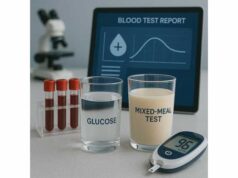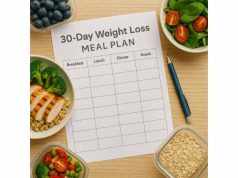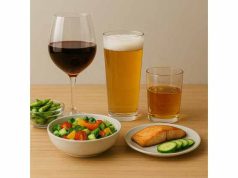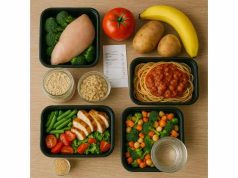
A vegan diet can be lean, filling, and performance-friendly when you center meals on protein, fiber, and smart portions. This 7-day plan shows exactly how to do it with tofu, tempeh, seitan, legumes, high-protein pasta, fortified soy yogurt, and targeted snacks. You will see daily protein targets, a complete week of menus, and templates you can repeat without cooking all day. If you want to set calorie and macro targets first, review our short guide to calorie and macro basics, then use the meal plan below to put the numbers into practice.
Table of Contents
- Does a vegan high-protein plan work?
- Vegan protein targets per day
- 7-day vegan high-protein menu
- High-protein vegan breakfasts
- Vegan lunch and dinner templates
- Vegan snacks, meal prep, and budget
- Supplements, safety and troubleshooting
- Frequently Asked Questions
Does a vegan high-protein plan work?
Yes—when you align protein, calories, and food volume, vegan diets can reduce body fat as effectively as omnivorous plans. The mechanism is simple: a steady calorie deficit plus meals that keep you full enough to maintain that deficit day after day. Protein is the anchor because it increases satiety and helps preserve lean mass while you lose weight. On a vegan plan, you’ll get most of your protein from soy foods (tofu, tempeh, edamame), seitan, legumes, and modern staples like high-protein pasta and fortified soy yogurt. A blended plant protein powder (pea plus rice) fills gaps on busy days.
Where many vegan eaters struggle is protein density. Beans and grains are nutritious but bring additional carbs and calories when used as the only protein source. The solution is to lead with concentrated proteins—tofu, tempeh, seitan, soy yogurt, or a shake—and then add legumes, vegetables, and grains for fiber, minerals, and satisfaction. This “protein-first” sequence gives you a meal that feels generous at 1500–1800 calories.
Food volume matters just as much. Vegetables, fruit, broth-based soups, and soy yogurt add water and fiber that stretch meals without stretching calories. Pair that with high-protein pasta or measured grains and you get a plate that fills you up while staying on budget.
Expect a realistic pace of about 0.25–0.75 kg (0.5–1.5 lb) per week with a 300–600 calorie daily deficit. Day-to-day scale bumps are normal from glycogen and water; track weekly trends and how you feel in the afternoon and evening. Your best early wins usually come from (1) upgrading breakfast protein, (2) shrinking liquid calories, and (3) building dinners with a predictable template.
If you need a refresher on the big-picture steps—setting a sensible loss rate, building meals around satiating foods, and troubleshooting plateaus—see our concise guide to safe fat-loss steps. Then come back here and plug your numbers into the plan.
Bottom line: A vegan high-protein plan works when it is repeatable, protein-forward, and vegetable-heavy, with measured grains and flavorful sauces used intentionally rather than accidentally.
Vegan protein targets per day
For fat loss with muscle retention, most adults do well with 1.6–2.2 g of protein per kilogram of body weight per day (0.7–1.0 g per pound). On a purely plant-based pattern, consider the upper half of that range if you train hard or prefer to limit protein shakes. At 70 kg (154 lb), that’s 110–155 g/day.
Distribute protein across the day
- Breakfast: 25–40 g
- Lunch: 30–40 g
- Dinner: 30–40 g
- Snack(s): 10–30 g to close the gap
Spreading intake across meals supports satiety and provides multiple “triggers” for muscle protein synthesis. Practically, this means anchoring breakfast with soy yogurt, tofu scramble, or a shake; lunch with tofu, tempeh, or seitan; dinner with a soy or seitan entrée or high-protein pasta; and snacks with edamame, soy nuts, or a small shake.
Protein sources that pull their weight
- Tofu/tempeh/edamame: complete protein with solid leucine content; easy to season across cuisines.
- Seitan: very high protein per calorie; avoid if gluten-sensitive.
- Legumes: lentils, chickpeas, black beans—excellent fiber and minerals; pair with soy or seitan to hit targets without overshooting calories.
- High-protein pasta and wraps: legume-based products add convenience for lunches.
- Plant protein blends: pea plus rice (and sometimes hemp) improves amino acid balance.
Quick per-serving estimates
- Firm tofu 150 g: 24–30 g
- Tempeh 120 g: 22–24 g
- Seitan 120 g: 35–45 g (brand-dependent)
- High-protein pasta 75 g dry: 20–25 g
- Soy yogurt 1 cup: 12–20 g (fortified varieties)
- Plant protein powder 1 scoop: 20–30 g
- Cooked lentils 1 cup: 17–18 g
Calorie targets in practice
- Smaller, active women often cut well at 1500–1700 kcal; many others land at 1700–2000+ kcal depending on size and activity.
- Keep fiber at 25–40 g/day for appetite control and regularity.
- Adjust weekly by outcome and hunger: if evenings feel difficult, move 10–15 g protein to the final meal.
For a deeper dive into setting daily protein by body weight and training, see our practical guide to daily protein targets.
7-day vegan high-protein menu
Below is a realistic week at ~1500–1800 kcal/day with ~110–150 g protein/day. Portions serve one adult; adjust to your energy target. Season with herbs, citrus, vinegar, soy sauce, and spices—big flavor, minimal calories. Drinks are water, coffee, or tea unless noted.
Day 1
- Breakfast: Tofu scramble (180 g tofu) with spinach, peppers; 1 slice whole-grain toast. 35 g protein, ~430 kcal
- Lunch: Tofu-edamame bowl (120 g tofu, ½ cup edamame) over ¾ cup cooked brown rice, mixed veg, sesame-ginger dressing (measured). 40 g, ~600 kcal
- Snack: Soy yogurt (1 cup) with berries. 15–18 g, ~220 kcal
- Dinner: Lentil and vegetable soup (1.5 cups) plus big salad and ½ avocado. 25 g, ~520 kcal
- Total: ~1,770 kcal, 115–118 g protein
Day 2
- Breakfast: Protein oats (½ cup oats cooked, stir in 1 scoop plant blend) with cinnamon and apple. 30 g, ~420 kcal
- Lunch: Tempeh taco salad (120 g tempeh) with lettuce, corn, tomatoes, black beans (½ cup), salsa, lime-yogurt dressing (soy). 38 g, ~560 kcal
- Snack: Roasted soy nuts (30 g) and a pear. 16 g, ~250 kcal
- Dinner: High-protein pasta (75 g dry) with marinara, zucchini, mushrooms, and 2 tbsp nutritional yeast. 30 g, ~600 kcal
- Total: ~1,830 kcal, 114 g protein
Day 3
- Breakfast: Savory soy-yogurt bowl (1 cup fortified soy yogurt, cucumber, tomatoes, za’atar, olive oil drizzle). 20 g, ~350 kcal
- Lunch: Seitan stir-fry (120 g seitan) with broccoli and bell peppers over ¾ cup jasmine rice. 45 g, ~620 kcal
- Snack: Edamame (1 cup, shelled). 17 g, ~190 kcal
- Dinner: Chickpea pasta primavera (75 g dry) with mixed veg and lemon-tahini sauce (measured). 28 g, ~580 kcal
- Total: ~1,740 kcal, 110 g protein
Day 4
- Breakfast: Smoothie: plant protein (1 scoop), soy milk (1 cup), frozen berries, spinach; optional flaxseed. 30 g, ~320–360 kcal
- Lunch: Mediterranean bowl: ¾ cup cooked farro, ½ cup chickpeas, cucumber, tomatoes, olives, herbs, dollop of soy yogurt tzatziki. 25–28 g, ~560 kcal
- Snack: Seitan slices (60 g) with carrot sticks and mustard. 18–20 g, ~180 kcal
- Dinner: Baked teriyaki tofu (180 g) with roasted broccoli and 150 g potatoes. 40 g, ~620 kcal
- Total: ~1,680–1,720 kcal, 113–118 g protein
Day 5
- Breakfast: High-protein pancakes (mix using plant protein); top with ½ cup soy yogurt and berries. 30–32 g, ~420 kcal
- Lunch: Red lentil dal (1.5 cups) with steamed greens and ½ cup basmati. 28 g, ~520 kcal
- Snack: Protein shake (1 scoop) and a small banana. 25 g, ~240 kcal
- Dinner: Tempeh “steak” (150 g) with green beans and ¾ cup cooked quinoa. 40 g, ~640 kcal
- Total: ~1,820 kcal, 123–125 g protein
Day 6
- Breakfast: Chickpea scramble wrap (¾ cup chickpeas mashed with spices) in high-protein tortilla with salsa. 28 g, ~430 kcal
- Lunch: Sushi-style bowl: 120 g baked tofu, ¾ cup rice, nori, cucumber, edamame (¼ cup), wasabi-soy dressing. 38 g, ~600 kcal
- Snack: Soy latte (unsweetened) and a small apple; or soy yogurt cup. 10–18 g, ~120–220 kcal
- Dinner: Seitan and vegetable stir-fry (120 g) with ¾ cup rice noodles; light peanut-lime sauce (measured). 40 g, ~650 kcal
- Total: ~1,800–1,900 kcal, 116–126 g protein
Day 7
- Breakfast: Overnight protein oats (½ cup oats, 1 scoop protein, soy milk, chia) topped with berries. 30 g, ~430 kcal
- Lunch: High-protein pasta salad (75 g dry) with cannellini beans (½ cup), arugula, roasted peppers, balsamic. 33 g, ~620 kcal
- Snack: Roasted soy nuts (30 g) and grapes. 16 g, ~250 kcal
- Dinner: Mapo tofu “light” (180 g tofu) with mushrooms and greens over cauliflower-rice mix plus ½ cup jasmine. 38 g, ~560 kcal
- Total: ~1,860 kcal, 117 g protein
Vegan swaps and notes
- Choose fortified soy milk/yogurt for calcium, B12, and vitamin D.
- If gluten-free, replace seitan with extra tofu or tempeh and use lentil/chickpea pasta.
- Prefer lower-oil cooking methods (baking, air-frying, nonstick sauté) to keep calories predictable.
For more structure ideas you can reuse week to week, skim our concise sample week structure and adapt it with the vegan choices above.
High-protein vegan breakfasts
Breakfast sets the tone for appetite control. Aim for 25–40 g protein with fiber and fluid for steady morning energy.
Reliable options that hit the target
- Tofu scramble (180 g) with vegetables; serve in a high-protein wrap or on whole-grain toast. 30–35 g
- Protein oats: cook oats in water, then stir in 1 scoop plant protein and cinnamon. 30+ g
- Soy yogurt bowl: 1 cup fortified soy yogurt, berries, 15 g nuts or seed mix. 20–25 g
- Smoothie: protein powder + soy milk + frozen berries + spinach. 30 g
- Chickpea-flour omelet with mushrooms and peppers. 25–30 g (depends on mix and filling)
Keep calories in check
- Measure calorie-dense adds (nut butter, granola, oil) with spoons, not estimates.
- Use spices (cardamom, cinnamon), citrus, and vanilla for flavor without extra calories.
Quick prep cues
- Batch-bake tofu on Sunday for scrambles and wraps.
- Pre-portion protein powder into small jars for grab-and-blend mornings.
- Freeze smoothie packs (berries, spinach, flax) to cut weekday friction.
For more fast morning ideas, take a look at our roundup of quick high-protein breakfasts and adapt each idea with vegan ingredients.
Vegan lunch and dinner templates
Templates remove decision fatigue while keeping variety high. Build your lunches and dinners from these three patterns and rotate sauces and spices.
1) Protein + big veg + smart starch
- Protein (30–45 g): tofu, tempeh, or seitan as the centerpiece.
- Big veg: 2–3 cups cooked or raw vegetables for volume (roast trays on weekends).
- Smart starch: ¾–1 cup cooked grains or 75 g dry legume pasta.
- Sauce: yogurt-style (soy) or measured tahini/peanut sauce; bright acids (vinegar, citrus) for lift.
2) Legume-forward bowls (measured)
- Base: ¾–1 cup cooked lentils or beans.
- Add: ½ portion grains, big veg, herbs, and a crunchy element (pickled onions, cucumbers).
- Protein boost: baked tofu strips or seitan to raise totals without overloading starch.
3) High-protein pasta or wrap
- Use lentil/chickpea pasta or high-protein wraps.
- Load with sautéed vegetables and a concentrated protein (tofu, seitan).
- Finish with bold flavor: pesto (reduced-oil), harissa, gochujang, or salsa verde.
Calorie control without constant tracking
- Plate vegetables first (half the dish).
- Add the protein portion you planned.
- Use measured starch and fats to finish.
- Eat until pleasantly satisfied; skip “clean-the-plate” habits.
For a visual cue system you can follow anywhere—from home dinners to salad bars—review the balanced plate method and mirror it with vegan proteins.
Vegan snacks, meal prep, and budget
Snacks should close protein gaps, not become stealth meals. Pick one go-to afternoon option and one evening option to curb grazing.
Protein-purposeful snacks (10–25 g)
- Soy yogurt cup with berries (15–20 g)
- Edamame (1 cup, shelled) (17 g)
- Roasted soy nuts (30 g) (16 g)
- Protein shake with water or soy milk (20–30 g)
- High-protein wrap with hummus and tofu (20+ g in half a wrap)
One-hour weekend meal prep
- Roast two trays (mixed vegetables and potatoes/squash).
- Bake or air-fry two blocks of marinated tofu and one tray of tempeh.
- Cook a pot of lentils and portion.
- Boil high-protein pasta; toss with roasted veg and vinegar; hold sauce for serving.
- Mix two sauces: soy-yogurt herb and spicy peanut-lime.
- Portion snacks (soy nuts, edamame) into small containers.
Budget stretchers
- Buy dry lentils and beans; cook in bulk and freeze flat.
- Choose store-brand soy milk and yogurt; buy large tubs.
- Watch for sales on tofu and tempeh; press and freeze tofu for chewier texture.
- Use bold condiments—vinegar, citrus, chiles—to amplify flavor without cost or calories.
Want a time-boxed workflow to make the week easier? Adapt the steps in our one-hour weekend plan to the vegan proteins above.
Supplements, safety and troubleshooting
A well-planned vegan diet can meet all needs, but a few nutrients deserve attention—especially during weight loss when calories are lower.
Consider (context-dependent)
- Vitamin B12: essential; use a reliable supplement or fortified foods.
- Vitamin D: common insufficiency; test and supplement as advised.
- Iodine: use iodized salt or a small supplement if you avoid seaweed and dairy.
- Iron: menstruating individuals and endurance athletes are at higher risk—pair plant iron with vitamin C and monitor symptoms.
- Calcium: choose fortified soy milk/yogurt and calcium-set tofu.
- Omega-3s: ALA from flax/chia/walnuts is helpful; consider algae-based EPA/DHA for coverage.
- Creatine monohydrate (3–5 g/day): supports training performance and lean mass while dieting.
Digestive comfort and adherence
- Increase fiber gradually if you are adding legumes and whole grains at once. Rinse canned beans well; cook dry beans until very tender.
- If high-fiber dinners disturb sleep, shift more vegetables to lunch and reduce late-evening volume.
- Use measured sauces and oils; calories from spoonfuls add up quickly.
Soy and health
- Soy foods (tofu, tempeh, edamame) are safe for most people and support protein quality on a vegan plan. If you have thyroid concerns, ensure adequate iodine and take any thyroid medication separately from high-fiber or soy-rich meals as advised by your clinician.
When progress stalls
- Recheck breakfast protein and evening snacking first—common friction points.
- Create a small, sustainable nudge: trim 100–150 kcal from starches or fats and hold two weeks.
- Confirm you are not “drinking calories” via sweetened coffees, juices, or alcohol.
Who should get personalized advice
- Individuals with kidney disease, anemia, GI disorders, or complex medication regimens should work with a clinician or dietitian to tailor the plan.
Frequently Asked Questions
How much protein should I eat on a vegan cut?
Aim for 1.6–2.2 g/kg per day, spread across three meals and a snack. For a 70 kg person, that is 110–155 g daily. Most people feel best anchoring breakfast with 25–40 g and hitting 30–40 g at lunch and dinner.
Can I reach 120 g protein without powder?
Yes, but convenience helps. Combine tofu or tempeh at two meals, high-protein pasta or seitan at dinner, and edamame or soy yogurt as a snack. Many still keep one scoop of plant protein on hand to cover busy days with minimal calories.
Do soy foods affect hormones or thyroid?
Typical intakes of tofu, tempeh, and soy milk are safe for most people. If you treat hypothyroidism, ensure adequate iodine intake and take thyroid medication away from high-fiber or soy-rich meals as your clinician advises.
What calories should I target for fat loss?
Many smaller, active women cut well at 1500–1700 calories; others do better at 1700–2000+. Pick a starting level, track for two weeks, and adjust by progress and evening hunger. Keep fiber at 25–40 g for steadier appetite and regularity.
What is the best vegan protein powder for weight loss?
Look for a pea-rice blend with 20–25 g protein per scoop, minimal added sugar, and a short ingredient list. Unflavored or lightly flavored powders are versatile in oats and smoothies and help you reach targets without adding many calories.
How do I handle eating out on this plan?
Scan menus for tofu, tempeh, bean-based dishes, or buildable bowls. Ask for sauces on the side, choose steamed or grilled options, and add a side vegetable. If portions are large, split the entrée or save half for lunch the next day.
References
- Vegan and Omnivorous High Protein Diets Support Comparable Daily Myofibrillar Protein Synthesis Rates and Skeletal Muscle Hypertrophy in Young Adults 2023 (RCT)
- High-Protein Plant-Based Diet Versus a Protein-Matched Omnivorous Diet to Support Resistance Training Adaptations: A Comparison Between Habitual Vegans and Omnivores 2021 (RCT)
- International society of sports nutrition position stand: nutritional concerns of the female athlete 2023 (Guideline)
- The health effects of soy: A reference guide for health professionals 2022 (Review)
- Changes in fatty acid levels after consumption of a novel docosahexaenoic supplement from algae: a crossover randomized controlled trial in omnivorous, lacto-ovo vegetarians and vegans 2022 (RCT)
Disclaimer
This article provides general nutrition guidance and is not a substitute for personalized medical advice, diagnosis, or treatment. Speak with your healthcare provider or a registered dietitian about your health history, medications, and lab values before making significant diet or supplement changes.
Share and follow
If this 7-day vegan plan helped, consider sharing it with a friend who wants a simpler, higher-protein way to eat plant-based. For more practical meal plans and evidence-based tips, follow us on Facebook, X, or whichever network you prefer.










